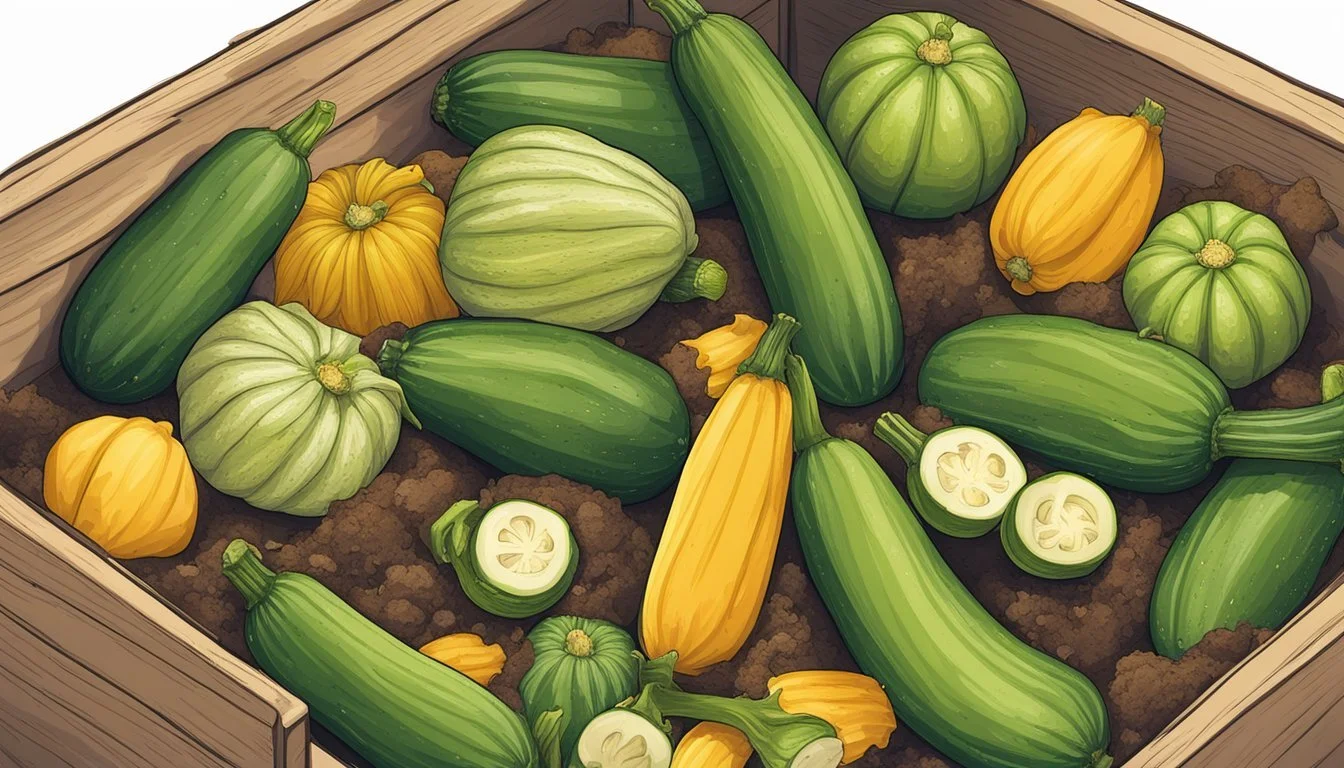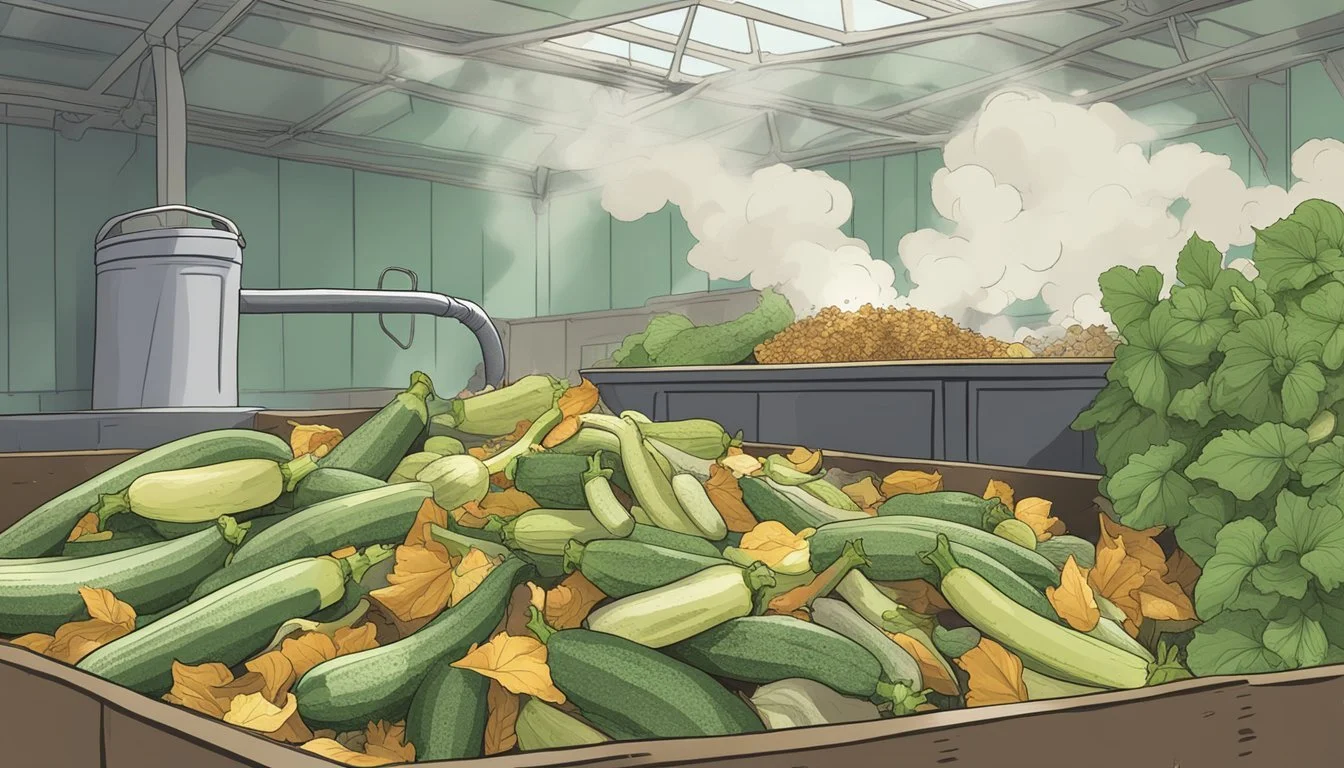Can You Compost Zucchini Ends?
The Quick Guide to Composting Vegetable Scraps
Zucchini (What wine goes well with zucchini?) ends and other vegetable scraps are a valuable addition to compost piles, as they are organic matter that can break down over time. When included in compost, zucchini contributes to the creation of a rich, nutrient-dense soil amendment useful for gardening. By composting zucchini ends, gardeners turn kitchen waste into a resource that enhances soil health and supports plant growth without the need for chemical fertilizers.
Composting is a natural process that recycles organic material such as leaves, vegetable scraps, and garden waste into a dark, crumbly, earthy-smelling material known as compost. When zucchini ends are added to a compost bin or pile, microorganisms and other decomposers such as worms break down the organic matter. As these materials decompose, they release nutrients back into the soil, helping to create a healthy growing environment for plants.
The process of composting zucchini ends is straightforward and contributes to a closed-loop system, minimizing waste and promoting sustainability in gardening practices. It's important to balance the mix of "green" materials, such as zucchini scraps, which provide nitrogen, with "brown" materials, such as dried leaves and branches, which provide carbon. This balance ensures the compost remains aerated and does not become overly moist, allowing for efficient decomposition and the generation of high-quality compost.
Understanding Composting
Composting transforms organic materials into a nutrient-rich soil amendment through a biological process involving microorganisms and careful balance of elements.
Principles of Composting
Composting requires four main components: carbon, nitrogen, moisture, and air. Organic materials such as leaves and branches provide carbon, while nitrogen comes from green materials like fruit and vegetable scraps. The microorganisms responsible for decomposition thrive in an environment that is moist but not oversaturated, and aerating the compost pile ensures a continuous supply of air for the bacteria to breathe.
Carbon (Brown materials):
Leaves
Twigs
Paper
Nitrogen (Green materials):
Fruit scraps
Vegetable scraps
Zucchini ends
Moisture: Sufficient water content is critical; materials should be as wet as a wrung-out sponge.
Air: Regular turning of the compost pile introduces air, which is essential for aerobic decomposition.
These elements combined allow for the efficient breakdown of organic materials by microorganisms, which includes bacteria and fungi. The composting process results in the production of heat, indicating microbial activity.
Benefits of Composting Zucchini Ends
Composting zucchini ends, specifically, contributes to a balanced nitrogen supply in a compost pile. Zucchini ends are considered green materials and they decompose relatively quickly, adding to the nitrogen content which is essential for the growth of beneficial bacteria.
Organic Material Return: Zucchini ends return valuable nutrients to the soil.
Reduction of Waste: Composting zucchini ends minimizes food waste in landfills.
Utilizing zucchini ends in compost provides garden plants with essential nutrients for their growth and contributes to a healthier garden ecosystem. These nitrogen-rich additions serve as an excellent soil amendment, improving soil structure, moisture retention, and plant health when mixed into garden beds.
Zucchini in the Garden
Zucchini, a type of summer squash, thrives in well-fertilized gardens with ample sunshine. This section focuses on the optimal conditions and techniques for growing and harvesting zucchini plants.
Growing Zucchini Plants
Zucchini plants require a sunny spot in the garden with well-draining soil that is rich in nutrients. Before planting, it's essential to prepare the soil by incorporating compost or aged manure to provide the necessary organic matter and nutrients. Zucchini seeds should be sown directly into the garden or started indoors if the growing season is short. Once the seedlings emerge, they need consistent and sufficient water, particularly as the plants grow and the vines begin to spread.
Adequate spacing is vital for growth to ensure proper air circulation around the foliage, which helps to prevent fungal diseases. Furthermore, the use of organic mulch can help retain soil moisture and suppress weeds. Regular application of a balanced fertilizer can promote healthy vines and prolific fruit production. Gardeners should be vigilant for common pests like squash bugs and diseases that can affect zucchini plants.
Harvesting and Using Zucchinis
Zucchini plants are prolific producers, and the harvest can begin in as little as 60 days after sowing, depending on the variety and growing conditions. For best flavor and texture, zucchini should be harvested when it's about 6 to 8 inches long. Harvesting zucchinis regularly encourages the plant to produce more fruit.
Once harvested, zucchini can be used fresh in salads, cooked in various recipes, or preserved by freezing or canning. The plant's organic matter, such as leaves and non-viable fruits, can be added back to the compost pile as "green" material, contributing nitrogen, which is essential for composting and will be beneficial for future garden fertility.
Prepping Zucchini Scraps for Compost
Composting zucchini ends is a practical way to reduce waste and create healthy organic material for garden soil. Proper preparation ensures that only disease-free scraps contribute to a thriving compost.
Cutting and Collecting Zucchini Ends
To optimize the composting process, it is best to cut zucchini scraps into smaller pieces before adding them to the compost pile. This increases the surface area exposed to decomposing agents, speeding up the breakdown. The steps are straightforward:
Wash the zucchini ends to remove any soil which might contain pathogens.
Chop the scraps into 1-2 inch segments to facilitate quicker decomposition.
Collect the pieces in a container that allows air circulation before transferring to the compost pile.
Disease-Free Scraps
A key aspect of composting zucchini ends is ensuring that the scraps are free of diseases. If a zucchini shows signs of fungal diseases, such as powdery mildew, or has started to rot, it should not be composted. Here are the specifics:
Inspect each zucchini end closely. Look for any discolorations, lesions, or growths indicative of disease.
Avoid composting scraps with any signs of such diseases, as they can persist in compost and infect other plants when used.
Composting only healthy zucchini scraps keeps the compost pile disease-free, aiding in the production of rich organic material that is beneficial for gardening.
Composting Process
Composting is a method to recycle zucchini ends and other organic materials into a rich soil amendment that benefits the garden. The process involves layering various materials to create a conducive environment for microorganisms to break down organic matter.
Layering Your Compost Pile
The key to a successful compost pile lies in the balance of green and brown materials, which provide nitrogen and carbon, respectively. A good ratio to follow is approximately two-thirds brown material to one-third green material.
Green Layers: Compostable kitchen scraps including zucchini ends, fruit peels, and coffee grounds.
Brown Layers: Dry leaves, straw, and small branches.
Alternate these layers to create a diverse mix that encourages microorganisms to thrive and facilitates even decomposition.
Maintaining Your Compost
Consistent maintenance is crucial for the composting process:
Aeration: Turn the compost pile regularly to introduce air into the system and prevent rot. This helps maintain a steady temperature that is critical for the composting process.
Moisture Levels: The compost should be moist, but not soggy. Adding water periodically or during dry spells will maintain adequate moisture levels.
Heat: The center of the compost pile should generate heat as a by-product of microbial activity, indicating that decomposition is occurring effectively.
Avoid placing your compost pile in overly wet areas or in full shade to ensure optimal conditions for the composting process to produce nutrient-rich soil for the garden.
Using Compost in Your Garden
Compost serves as a vital component in establishing a healthy and productive garden by enhancing soil structure and providing essential nutrients.
The Role of Compost in Soil Health
Soil health is fundamental for a successful garden, and the integration of compost is critical in achieving a well-balanced growing environment. Compost improves soil structure by contributing to aeration and fostering beneficial microbial activity. Such biological activity is crucial as it aids in the breakdown of organic materials, which in turn releases nutrients that plants require for growth.
Water retention is another important aspect influenced by compost. The presence of compost in soil allows it to hold water more effectively, ensuring that plants have a consistent water supply between waterings or rainfall, reducing the need for frequent irrigation.
Application of Compost to Garden Beds
When applying compost to garden beds, a methodical approach ensures the maximum benefit:
Step 1: Test your soil to determine existing nutrient levels.
Step 2: Spread a layer of compost about 2-3 inches thick over the garden bed.
Step 3: Gently mix the compost into the top 6-8 inches of soil.
Step 4: Water the bed lightly to settle the compost.
By following these steps, gardeners can create a nutrient-rich soil foundation that supports plant health and increases yield. Composting is particularly beneficial for vegetable gardens, where nutrient demands are high, and soil health is paramount for producing abundant, healthy crops.
Troubleshooting Common Composting Issues
When composting zucchini ends or other organic materials, one may encounter challenges such as attracting unwanted pests or dealing with diseased plant materials. These issues can impede the composting process, but with appropriate strategies, they can be managed effectively.
Pests and Rodents
Pests such as flies and rodents are attracted to compost bins because they provide a ready source of food. To deter these unwanted visitors, ensure that zucchini ends and other food scraps are well-covered with brown materials like dry leaves, straw, or shredded paper to mask odors that attract pests. Composting bins should have a secure lid and, if necessary, a wire mesh base to prevent rodents from digging their way in. One should also avoid adding meat or dairy products, as these can increase the likelihood of pest problems.
Composting Diseased Plant Material
Diseases can be a significant issue when composting plant materials like zucchini ends. If the zucchini shows signs of rot or is infected with bacteria or fungi, adding it to the compost pile might spread the disease to the entire pile. The compost should reach temperatures high enough to kill most plant pathogens; however, it is safer to avoid composting diseased plants, especially in a home system where temperature control can be less precise. If diseased material has been added unintentionally, one should monitor the pile for unusual growth or smells and remove any suspicious material promptly.
Other Compostable Garden Waste
In the gardening realm, compost is a crucial element for maintaining soil health and sustainability. A wide array of garden waste can be composted, which includes both green and brown materials.
Green materials refer to nitrogen-rich waste, such as:
Vegetable scraps
Grass clippings
Leaves [in moderation to avoid matting]
Plants without seed heads
Garden weeds [ensure they have not gone to seed]
These materials are often moist and decompose quickly, adding necessary nitrogen to the compost mix.
Brown materials, on the other hand, provide carbon and include:
Small twigs
Dry leaves
Straw
Sawdust from untreated wood
These are typically drier and decompose at a slower rate, balancing out the moisture from green materials and aiding in air circulation within the compost pile.
Composting yard waste effectively creates a rich, organic mulch that can benefit garden beds by retaining moisture and suppressing weeds. However, it's important to omit diseased plants and invasive weeds to prevent the spread of pathogens and unwanted growth within your garden.
When thinking about larger garden waste like branches from trees, they should be chipped or shredded before being added to the compost in order to accelerate decomposition. Even then, larger branches are better used as mulch directly or set aside for municipal collection if available.
Remember to maintain a balance of green and brown materials, providing an optimal environment for decomposition, and turn the pile regularly to encourage aeration and speed up the composting process.






